John ‘Lurch’ O’Neill
John O’Neill could never understand why his teammates called him ‘Lurch’ when he first came down to Sydney from Gunnedah in 1965. At 6 foot 2 inches and 16 stone, and with a cold stare that would put opposing forwards in a trance, O’Neill conceded he only had a passing resemblance to the ghoulish doorman from the then popular Addams Family television show.
In a newspaper article at the time O’Neill recalled. “One of the Souths players said out there on the field he looks a bit like ‘Lurch’ doesn’t he? When someone sticks a brand on you and everyone starts calling you by the nickname you either accept it or cop a fight or two. I accepted it; it doesn’t worry me anymore but it took a long time to get used to.”

Born In Griffith
John Bernard O’Neill was born in Griffith NSW on the 9th of May 1943. After moving to Gunnedah he was a first grader at age 16. He played his first representative match for Northern Districts in 1961 as a second rower against Newcastle. A Country Firsts representative in 1964, he played for NSW Colts against France later that year. “Ron Coote, Bob McCarthy, Bob Moses and Les Johns played in that game…not a bad quartet to play with.” he later remarked. It was this match that led to Souths making O’Neill an offer for 1965.
2 Chippies
O’Neill was a 21 year-old carpenter when he left the family home at Gunnedah and ventured to Sydney. He linked up with another ‘chippie’ at the club, Gary Stevens, and they formed a building company together renovating houses.

‘Mick’ & Clare
He married his girlfriend Clare, whom he met at Tambar Springs when they were teenagers (Clare’s pet name for O’Neill was ‘Mick’). They raised three daughters together; Michelle, Julie and Cindy.
In 1965 there were a number of new faces at Souths. Jim Morgan and Bobby Moses from Newcastle, Ivan Jones from Brisbane and O’Neill from Gunnedah. “Get a load of the bush boy haircuts,” was one remark when the quartet turned up for pre-season training at Waterloo Oval. “I can still remember those big eyes of his getting bigger whenever someone told a story,” John Sattler recalled fondly. “Yeah?” he’d say. “He was a big, raw-boned country boy until the day he died. He was as tough as teak and if he made up his mind to do something, that was it! Nothing changed it. He was like that in business as well.”
Earned His Striped
O’Neill quickly earned his stripes that year, playing in all 21 premiership matches alongside Jim Morgan and clubmen Dennis ‘Sluggo’ Lee and Richie Powell. O’Neill at full charge was a fearful sight for opposing forwards. One press report stated: “In his first match with the Rabbitohs he showed the granite toughness, the crashing runs and the punishing tackles that have made him one of Sydney rugby league’s most rugged props.”

Lessons Learned
But there were lessons to be learned along the way. Two matches he played that year, against St George at the SCG and Balmain, at the Sports Ground, were two he would never forget. “There was I, a kid from the bush, a country hick, stacked up against probably the best props in Sydney”, he later said. “I copped the lot but I must have done all right because Souths were pleased enough to keep me in the team.” In the match against defending premiers St George, which Souths won 14-4, hooker Freddy Anderson warned him: “If Norm Provan had connected with that stiff arm he threw at you, your head would have been over the goalposts.”
Knocked Out Cold
A hardened Tigers’ outfit defeated Souths, 20-7, the following week. The word had got out about the young country prop that had terrorised Saints’ star forwards. But in this match against the Tigers O’Neill was knocked out cold early in the contest. “Bobby Boland did it,” O’Neill later recalled. “I went down in the scrum and something hit me. Next thing I know I was looking up at the first aid man. It kind of upset me … years of (playing) football and never before out like a light. But Bobby was really nice about it. He patted me on the shoulder and said “Sorry I had to do that ‘Lurch’ but you were going too well. Had to slow you down a bit.”
O’Neill learned quickly but he was still young for a prop forward. ‘Raw-boned,’ as John Sattler called it – and he was not yet ready for the rigors of representative football. Taking on St George in the grand final in front of 78,000 people after qualifying in third place on the competition table was another huge learning curve for O’Neill and Souths. Missing the play-offs in 1966 was another lesson for the young Souths outfit. The ensuing years would however, be golden for the Rabbitohs.
A Grand Final Try
O’Neill made his NSW debut in 1967 and shifted to loose-head prop in the grand final when Jim Morgan succumbed to injury and second rower John Sattler was promoted to prop. O’Neill scored the opening try of the grand final against Canterbury after only eight minutes of play.
Going to dummy half after a long break, O’Neill crashed over from close to the Canterbury tryline to give Souths an early 5-2 lead. Grand final success that year did not lead to further representative honours for O’Neill, however, who would have to wait another three years for his Test jersey.
He Got Me Cold
In the 1968 grand final O’Neill and Bobby Honan both had their noses broken in the first half.
O’Neill was in a fearful mood at halftime in the dressing room threatening to get even with the Manly player who got him in a high tackle. O’Neill said. “He got me cold”. Souths officials and coach Clive Churchill took him aside and quietened him down. “We couldn’t afford to risk him being sent off,” said (Club President) Denis Donoghue. When Souths won 13-9, O’Neill did his lap of the SCG with a Manly jersey draped around his neck and blood splattered all over his face as badge of honour.
O’Neill played hard on and off the field. His building business with Gary Stevens had taken off and he was now renovating terrace houses in the inner city. Other Souths players such as Ivan Jones, Bobby Moses and Bobby Grant worked on the projects. Bob Honan and Jim Lisle were also involved behind the scenes and doubled as drinking buddies card partners. “We knocked around a bit in those days,” Ivan Jones told me. “Three larrikins – John O’Neill, Bobby Moses and me. John and me clicked straight away… the biggest fella on the field and the smallest.”
Cards On The Cruise
‘Lurch’ never backed off an inch, and ended up having one of the great careers in the game. At that time O’Neill was a demon for playing a game of cards. Euchre, bridge, poker, Rickety Kate were played at the Cauliflower Hotel after work and football training.
At the end of the 1968 season Souths’ first grade squad sailed to Perth on the Oriana. When the ship got under way O’Neill, Bobby Moses and Club Secretary Charlie Gibson and others sat down to a game of poker. They were still going strong when the ship arrived in Melbourne and well into the Great Australian Bight. Seasickness couldn’t stop them, and they finally called it a day three hours before berthing in Perth. The following year the club booked a cruise to Noumea and Suva.
O’Neill and Moses missed the briefing conference in the Souths boardroom because they were playing cards at the ‘Cauli’. When informed of that they were missing the meeting, O’Neill remarked “What’s the panic. The ship doesn’t sail until tomorrow.”
We’ve Got ‘Em Buggered
The 1969 grand final loss to Balmain never sat well with any of the Souths’ greats, but especially for O’Neill, the fiercest of competitors. “To this day I can still remember the late John O’Neill saying, “We’ve got ’em buggered, we’ve got ’em buggered. C’mon! C’mon!” Michael Cleary recalls. “He was still saying it at the end of the game when Balmain beat us. The whistle had gone, the game was over and they completely had us stuffed.”
By the end of the decade O’Neill’s once lean frame had filled out to more than 17 stone and the ‘bush boy haircut’ was now fashionably long. Bob McCarthy laughs at the memory. “The official program had me playing at 14 stone 10 Ibs, but that was my Jersey Flegg weight. I was almost 16 stone by then. John used to always have a go at me about it. The program had him at 17.2 and I wasn’t far behind him. “Why don’t you tell them your real weight?” he’d complain. I used to just laugh, “I’m not telling them anything …people might think I was a fat prick like you.”
Quick With The Fists
‘Lurch’ was a lot quicker than people realised. Gary Stevens recalls. “He was very mobile for a big guy, and quick with the fists and quick to anger. I partnered Bob McCarthy in a game against Parramatta one day and ‘Lurch’ thumped someone in the opposition scrum and the forwards started to look at us like daggers. ‘Macca’ said, “Great work son, they’ve been quiet all match, and we ended up copping it from them.”


O’Neill was again passed over for Test duty in 1970 (his former prop partner Jim Morgan played two Tests against Great Britain that year having shifted to Easts) but there was no denying his credentials following Souths’ win over Manly in the grand final at the end of the year.
A Classic Front Row Forward
O’Neill punished the Manly forwards after Sattler had his jaw broken and was selected in Australia’s World Cup squad on grand final night. Clive Churchill told pressmen O’Neill had “Developed into a classic front row forward (a) good ball handler (who) played close to the ruck and knows how to niggle forwards and lead them into indiscretions. He’s a past master of the softening up process. Just watch the way he runs with the ball and how he hits a tackler. And keep an eye on him when he is making his tackle – you’ll see that it’s generally the tackled man who comes off the second best.”
Not that everything was beers and backslapping on grand final night. O’Neill and Michael Cleary fronted officials back at the Leagues Club when they learned that they had failed to check on John Sattler. John was in hospital having his jaw wired but the officials dined at an inner-city restaurant while the players feasted on ‘sandwiches and cold pies’ among a sea of fans. O’Neill later claimed he even ‘cuffed’ one or two officials that night when they tried to defend their actions.
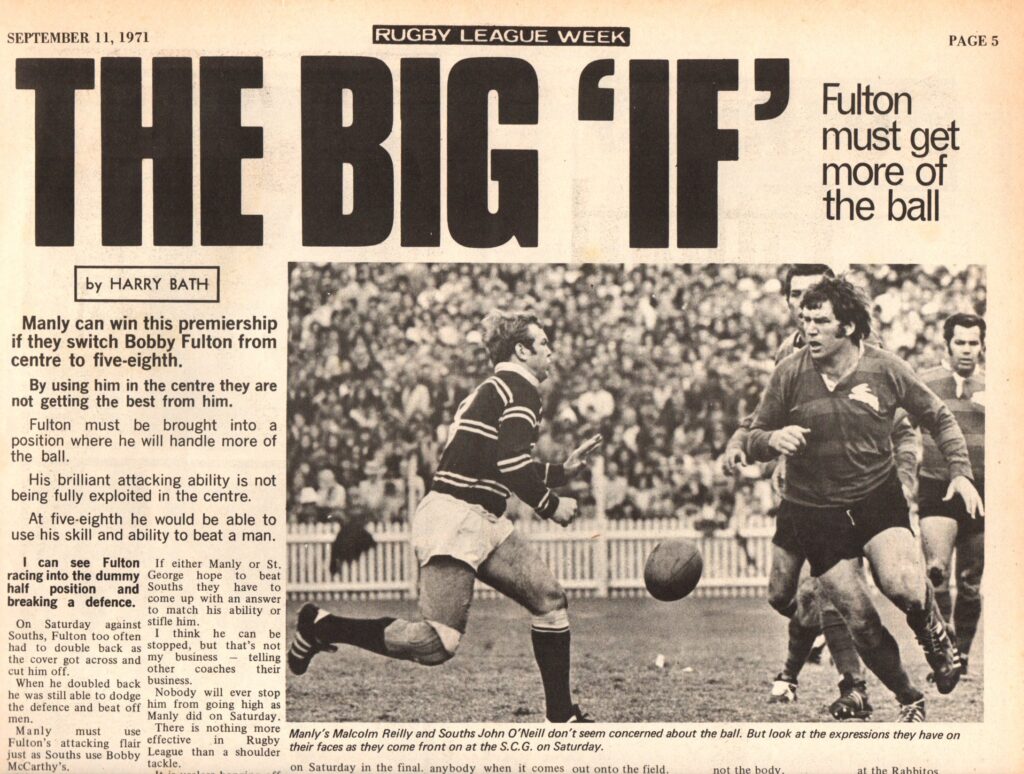
The World Cup Squad
As a result Cleary was placed on open transfer the following year. Souths’ officials stalled contract negotiation with O’Neill, who was about to achieve his highest honour with selection in Australia’s World Cup squad.
“I was that keen to go I was scared to cross the street in case something happened,” O’Neill told journalist Tony Adams in his book Hit Men. “That’s how much it meant to me.”
You Can’t Do That
Having lost the Ashes earlier that year Australia were underdogs for the World Cup final against Great Britain in Leeds. “Our coach Harry Bath said we had to starve them off the ball,” Bob McCarthy remembers. “He suggested Ron Turner, our hooker, put mercurochrome in his hair and rub it in the eyes of the Great Britain hooker. It burns like hell, Harry said, and they used to do it ‘in the old days’ in English club football. Ron Turner said, “Harry you can’t do that!” John O’Neill said that he would but Ronnie Coote said no, we wouldn’t do it. We had tried everything; punching them from the second row, screwing the scrum, but nothing worked. We went for another plan to upset their front row.
World Cup captain Ron Coote takes up the story. “Harry Bath got one of his mates down to our training – a hooker for Great Britain who had played something like 400 games in English club football – to give us some tips about how we were going to win the ball. He told ‘Lurch’ he had to grab Dennis Hartley, the opposite front rower, by the fat around his ribs. A lot of the trouble in the scrums and the fights among the forwards came from that. It was a win-at-all-costs game.”
“Lurch had big hands and he had big fingernails too and he just kept grabbing Hartley by his guts. I can still hear the Pommy yelling out to the referee, “He’s nipping! Sir! He’s nipping here!” That’s why they kicked ‘Lurch’ in the leg and ripped a big piece out of his shin.”
A Famous Victory
The Great Britain forwards threw everything at O’Neill, hoping that he would lash out and be sent off in the Final. At one point in the hectic finish to the match, O’Neill was kicked in the head when Malcolm Reilly hurdled a tackled player. O’Neill finished the match with a gashed cheek and a split chin but he never lost his cool and Australia recorded a famous victory. O’Neill used to laugh at the postscript to the match. A couple of minutes before the end of the Final, and with the result still very much in the balance, Hartley sidled up to O’Neill in a scrum and said.
“Hey John, want to swap jumpers at the end of the game?”
“Can you believe that?” O’Neill told his teammates, shaking his head. Hartley’s ribs were red raw on one side.
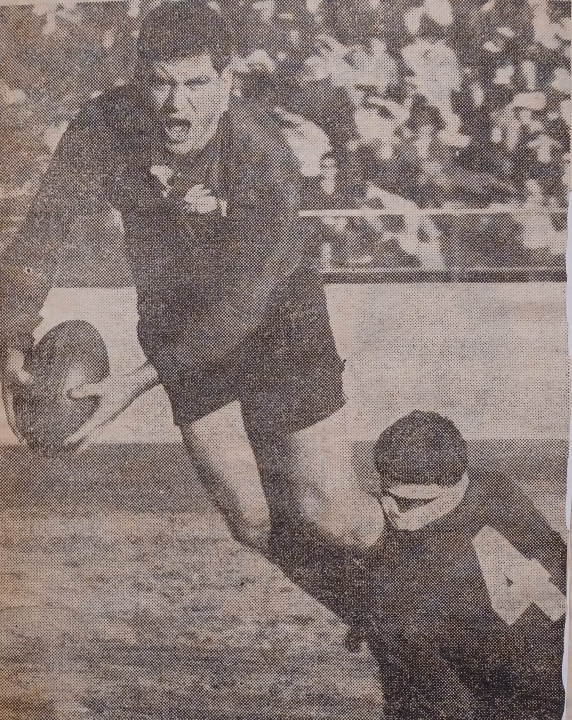
A Fierce Rivalry
The 1970 World Cup tour also started one of the game’s fiercest rivalries. Champion St George halfback Billy Smith, the wild man of rugby league’ in the era, was named vice-captain to Ron Coote in England. Smith reformed his ways and supported Coote to the letter. O’Neill did not take kindly to taking orders from a halfback, and a St George halfback at that. When he took umbrage at something Smith said, the plucky halfback challenged the front rower to settle their differences outside. O’Neill was only too glad to oblige him.
As fate would have it, Souths took on St George in the opening round of the 1971 season at the SCG. As O’Neill took the ball up, Smith hit him across the forward in a stiff arm tackle.
O’Neill’s forehead split open like a peach and he had to leave the field to have it stitched by trainer Alf Richards, the same man who had stitched his wounds in England the previous November.
Unknown to O’Neill, the rest of the Souths team and the crowd of 27,000, Smith suffered a fractured arm in the tackle. Staying on the field so the opposition wouldn’t know he was injured, Smith was picked up and driven in a tackle by Gary Stevens. At the last moment, Smith thrust his arm out to cushion the blow and shattered the arm in several places.
Hate To Mates
“We hated each other with a vengeance,” Smith told me in an interview in 2003. “But we became the best of mates after we stopped playing against each other.”
O’Neill returned from England with the reputation as being the best prop in the world but he lost a lot of the discipline he found on tour trying to maintain that reputation. John Sattler remembers,
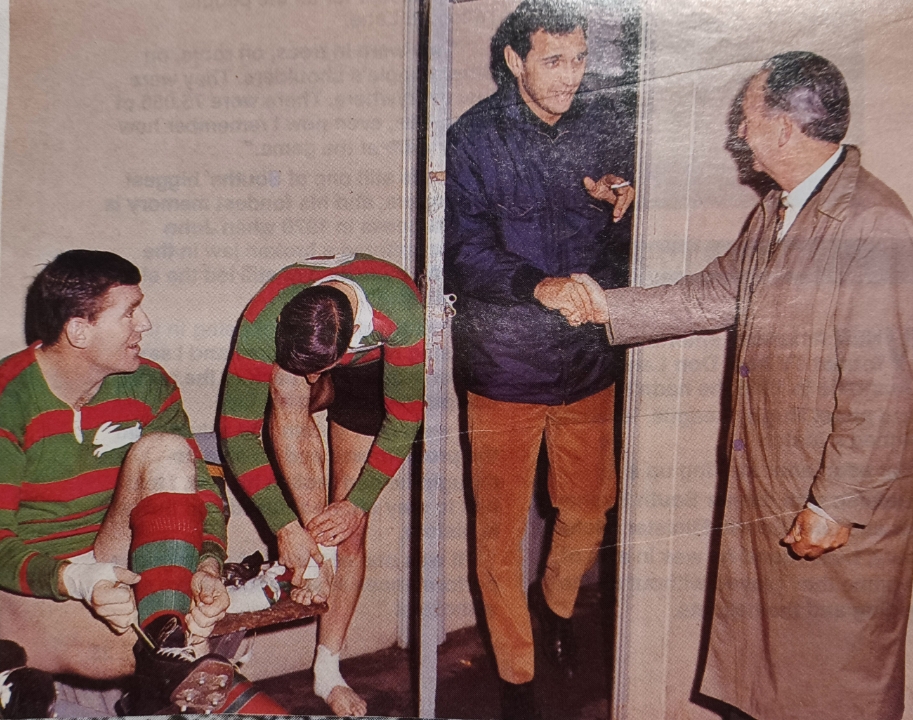
Keith ‘Yappy’ Holman, the old Test halfback, was a referee at the time and he wouldn’t shut up during a match, telling us how to pack the scrum and then penalising us. Later ‘Yappy’ was standing between two packs, reading us the riot act when ‘Lurch’ lost it and called out “now” and charged forward to pack the scrum with Holman still in the middle. Holman pointed his finger at us and said, “do that again and you’re both off?”
Barry Beath
In the match against Parramatta that year O’Neill was sent from the field for kneeing his World Cup forward partner Bob Reilly in a tackle. He was suspended for three weeks. In his return match against Saints at the SCG he again used knees in the tackle and split opposing forward Barry Beath’s forehead open.
Sent from the field, O’Neill was vilified in the press and turned up to Phillip Street with team-mate Bob Honan fearing the NSWRL Judiciary would rub him out of the game. He was subsequently suspended for five weeks and missed the Australian tour of New Zealand. His burgeoning ‘rep’ career had quickly hit rock bottom.
Moving To Manly
O’Neill returned to the field in the run to the grand final, with Souths always in control against St George. When his contract came up for renewal at the end of the year Souths officials showed they had long memories. They delayed negotiations over Christmas as punishment for his standing up to them. When teammate Ray Branighan revealed to O’Neill that he was leaving the club to play for Manly in 1972, O’Neill made the decision to contact Manly Secretary Ken Arthurson to see what the Sea Eagles could offer him. He would play in maroon and white for the next three years.
In 1972 O’Neill missed the Test series against New Zealand but played in Manly’s maiden grand final success before travelling to France for the World Cup. The following year he made his seventh straight grand final appearance. This was his eighth in nine years – as Manly defended its premiership against a plucky Cronulla team.
The Hardest Grand Final
That 10-7 win over the Sharks has since gone down in history as one of the hardest grand finals on record. O’Neill told Tony Adams some years ago, “The 1973 grand final was boots and all. Of all the grand finals I played in that’s the one people ask me about. It’s the game they all remember. And it’s not because of the quality of the football … At one stage their little halfback Tommy Bishop, who was a cheeky bugger, kicked me in the shins. I started chasing him but he ran and hid behind Cliff Watson. I nearly caught up with him a few times, but he was too slippery. Games like that were hard, but they were great to play in.”
‘73 Kangaroo Tour
On the 1973 Kangaroo Tour O’Neill suffered a broken cheekbone and missed the Ashes series against Great Britain. Playing against Widnes in the fifth match of the tour, O’Neill scuffled with local forward Bob Blackwood in a tackle, who then quickly got to his feet, played the ball and busted O’Neill’s cheekbone with a head-butt. O’Neill couldn’t retaliate because he already had an injured hand and Blackwood was sent off for the incident but the damage was done. O’Neill missed the English leg of the tour but made his comeback in the Test series against France.

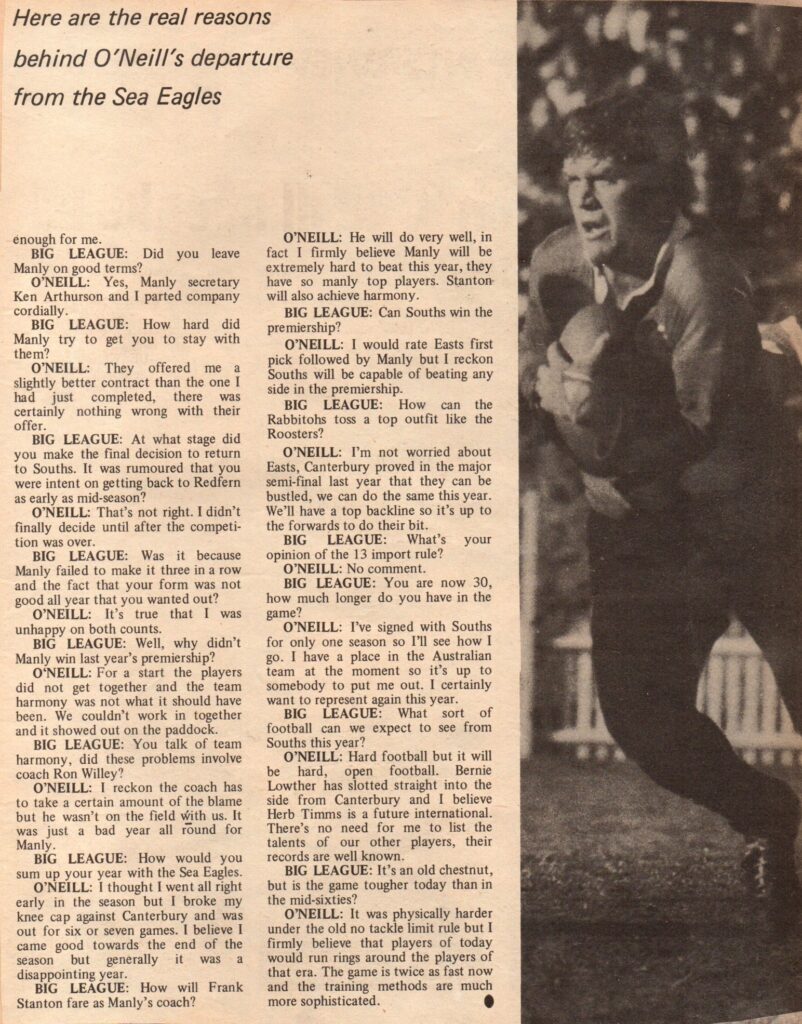
In 1974 O’Neill joined former Souths teammates Ray Branighan, Ron Coote, Bob McCarthy, Gary Stevens and Paul Sait in Australia’s Ashes-winning Third Test team but when his when three-year contract ended with Manly’s semi-final defeat at the end of the year it was no surprise to see him back at Souths in 1975.
Never Comfortable At Manly
“Lurch didn’t really feel comfortable at Manly,” John Sattler told me. “He would always come back after the game to drink with the Souths boys. He said he couldn’t get over the Manly fellas after training. They never got together to have a drink. They just went home. He changed that. Terry Randall told me once that ‘Lurch’ O’Neill taught Manly how to win the tough matches.”
201 First Grade Games
Rabbitohs fans hoped that O’Neill’s return would be the signal for a return to the club’s halcyon days. After a promising start to the season he joined George Piggins, Gary Stevens and Paul Sait in Australia’s World Series team. The season ended in disaster, with O’Neill injuring his shoulder and the team capturing the wooden spoon after Clive Churchill resigned as coach with five games remaining. O’Neill played in just eight matches for Souths in 1976. This took his first grade tally to 201 (150 for Souths) before he announced his retirement.
“They were great days,” O’Neill told Tony Adams in the early 1990s, “but they went too bloody quick.”
10 Tests
The veteran of 10 Test appearances (including 8 World Cup matches) O’Neill surprised many when he put his hand up for the vacant coaching position at Souths. With Bob McCarthy and Gary Stevens leaving the club for Canterbury, O’Neill only had Paul Sait and George Piggins for leadership at the club.
George Piggins recalls, “Lurch took over the job but soon realised he didn’t have the time to devote to it. He had a very successful building business and quickly realsied he couldn’t turn up at five o’clock in shorts to coach a bunch of footballers. He had to prepare, get the team ready for its next match. John thought, “What have I done?” He picked a job paying a $1000 a year when his business was turning over millions.”

3 Games In 1977
Souths won three games in 1977, finishing second last, and O’Neill realised he had made a mistake so he went to see premiership-winning coach Jack Gibson about taking over the coaching reigns at the club. In the 1980s he concentrated on his considerable business interests.
He was a director with Gary Stevens in a building company that employed around 40 people and had among their many projects, a multi-million dollar refit of the Coogee Bay Hotel. The pair also ran the Giles sporting centre in Coogee and invested in the Court House Hotel with Bob McCarthy and Richie Powell in Redfern for a reported $850,000.
O’Neill had the foresight to sell out before the deal soured, and retained a vigorous business regime right up to the diagnosis of his illness. In the mid 1980s he invested in acreage at Lake Conjola on NSW’s South Coast with former team-mates Ron Coote, George Piggins and Gary Stevens, and built his dream house there on the water.
John’s Toughest Battle
The rugby league public, however, knew little about O’Neill’s toughest battle. In the mid 1990s he was diagnosed with bowel cancer.
In 1998 journalist Paul Kent wrote a small snippet in the Daily Telegraph when O’Neill re-entered hospital. “As footballers go, former South Sydney prop John O’Neill was tough. Even his nickname – ‘Lurch’ – was tough. Sad to see then, that O’Neili isn’t doing so well after entering St George Hospital this week to have cancer removed from his body. O’Neill never changed from the boy who used to concern his poor mum while she ran the corner shop in Gunnedah and he played in the big smoke. Back then, the ABC match of the day was on the Saturday afternoon and O’Neill was often on telly, turning the opposition into a pile of blood clots. Still, whenever anyone walked in for two-bob’s worth of mixed lollies, they were always met with Mrs O’Neill’s: “Did you see what they did to my Johnny today?”
A Very Sad Day
The once commanding frame of John ‘Lurch’ O’Neill was skeleton-thin when he succumbed to cancer in August 1999, aged 56. He was buried on 9 August, the same date Clive Churchill died 14 years before. His service at St Marys Cathedral was attended by a large crowd of mourners from all walks of life.
Ron Coote
“It was very sad when John O’Neill passed away,” Ron Coote reflected when I caught up with him at Lake Conjola. Across the water is the home he built with wife Clare. “He’s been gone 11 years now. We were very close. We used to sit on the verandah after a hard day’s work down here. He got cancer and fought really hard for five years. He never looked after himself, ‘Lurch’. I told him to go and have a colonoscopy but he wouldn’t go.
When he finally did have one and they diagnosed cancer he said he wished he’d listened to me. You know, when you’re over 40 you’re supposed to do it every two years. I did, and I said to him that he should too. He had an operation but he didn’t change his lifestyle too much. He was always a big drinker. Three years later the doctor said to him, “It looks like you’ve beaten this. Everything looks good. But on your way out you’d better go and have a blood test, just to be sure.” The blood test came back and the cancer had returned. He had five years from when he was first diagnosed until he died.”





George Piggins
His friend George Piggins devoted a chapter to O’Neill in his 2002 biography, Never Say Die.
Piggins wrote: “John was a funny bugger and when you had him as a friend, he was a friend for life, as his old mates from Gunnedah could testify. He was as close to them when he was a star footballer and successful city businessman as when he first left town to try his luck in Sydney.”
“He had time for everybody. When I think of him, I think of a bloke who never lost his country qualities, but was very ‘South Sydney’ too. Friendships meant a lot to him, and he would go out of his way to make sure they were sustained; the Gunnedah crowd, football mates from tours, the blokes at Souths he had played with.”
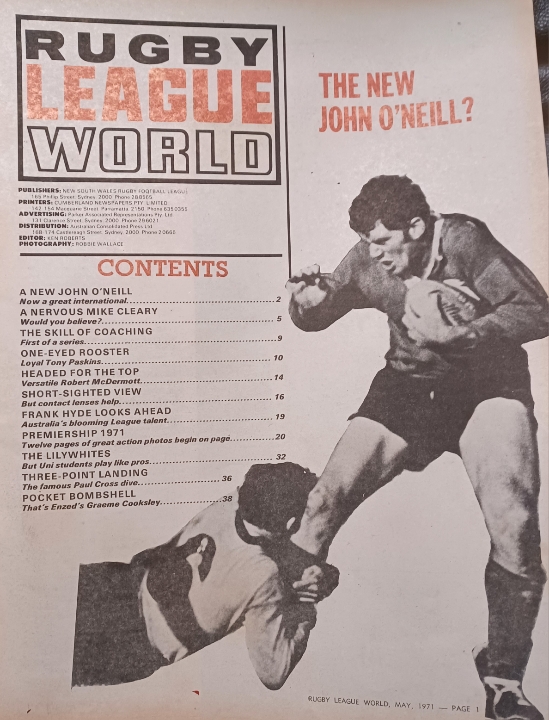
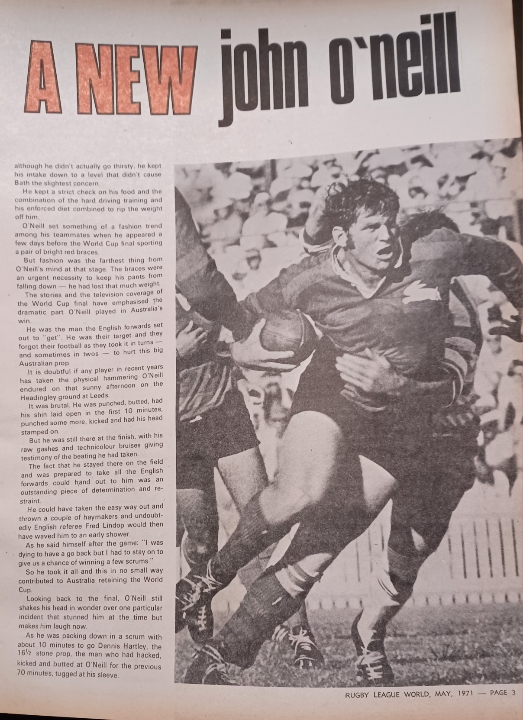
Team Of The Century
When Souths and Manly named their respective ‘Teams of the Century’, John O’Neill was selected in the front row of both teams. In 2008 he was named in the Top 100 ARL Players of all time alongside Souths team-mates John Sattler, Ron Coote and Bob McCarthy. Gary Stevens says: “With John, his word was his bond from the get go. His illness hit everyone hard. It was frightening, really, but he fought it to the end. He was a good party man, ‘Lurch’ he had the lifestyle of ten men.”

John ‘Lurch’ O’Neill
By Brad Ryder for Bunnies TV. Article reproduced from the book ‘Glory Days’ by Alan Whiticker (2012) with Brad Ryder as a contibutor. Selected images with thanks to Mark Emery.



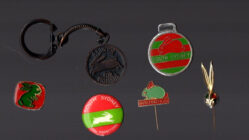
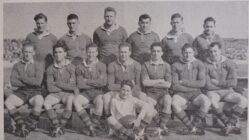
Introduced to John in 1966 by Gus Wilson in the Whitehouse hotel after training.
As I was an Carlton supporter at the time rugby league meant nothing to me.
Fast forward 34 years and as a casual Rugby league follower the plan to throw the Rabbitohs out of the comp started my love affair with the Bunnies.
A trip to Sydney a few years ago led me to the Sydney City RSL for a few beers and Lurch was in there working and I reintroduced my self to him and even though he did not know me from a bar of soap we had a great talk.